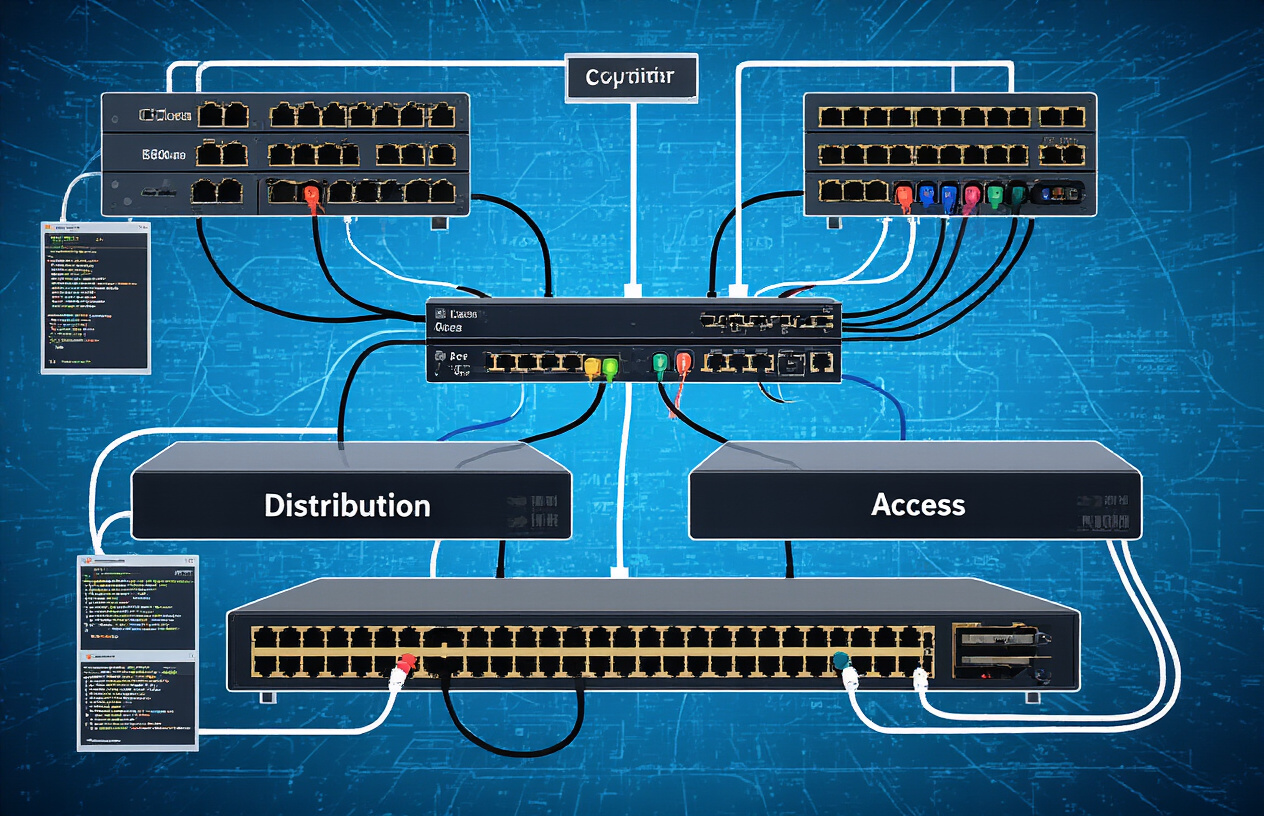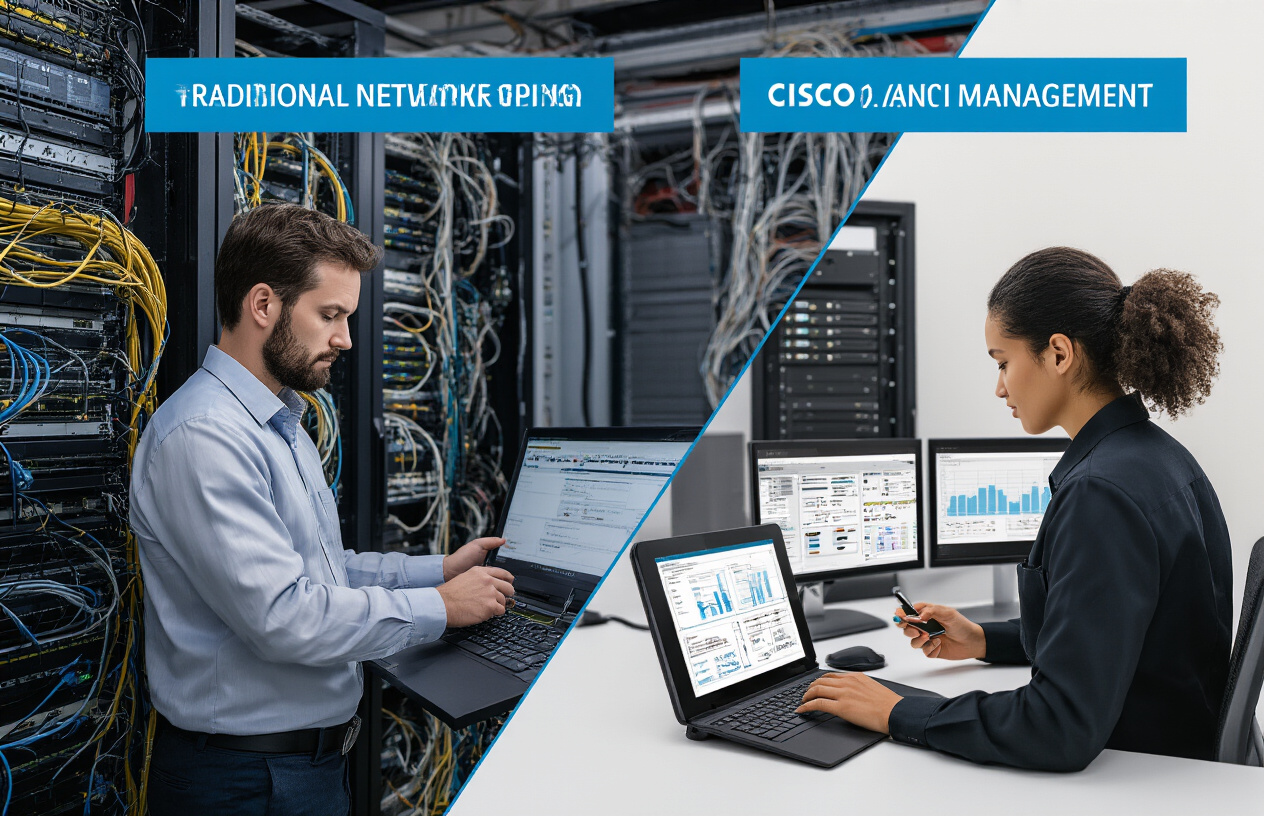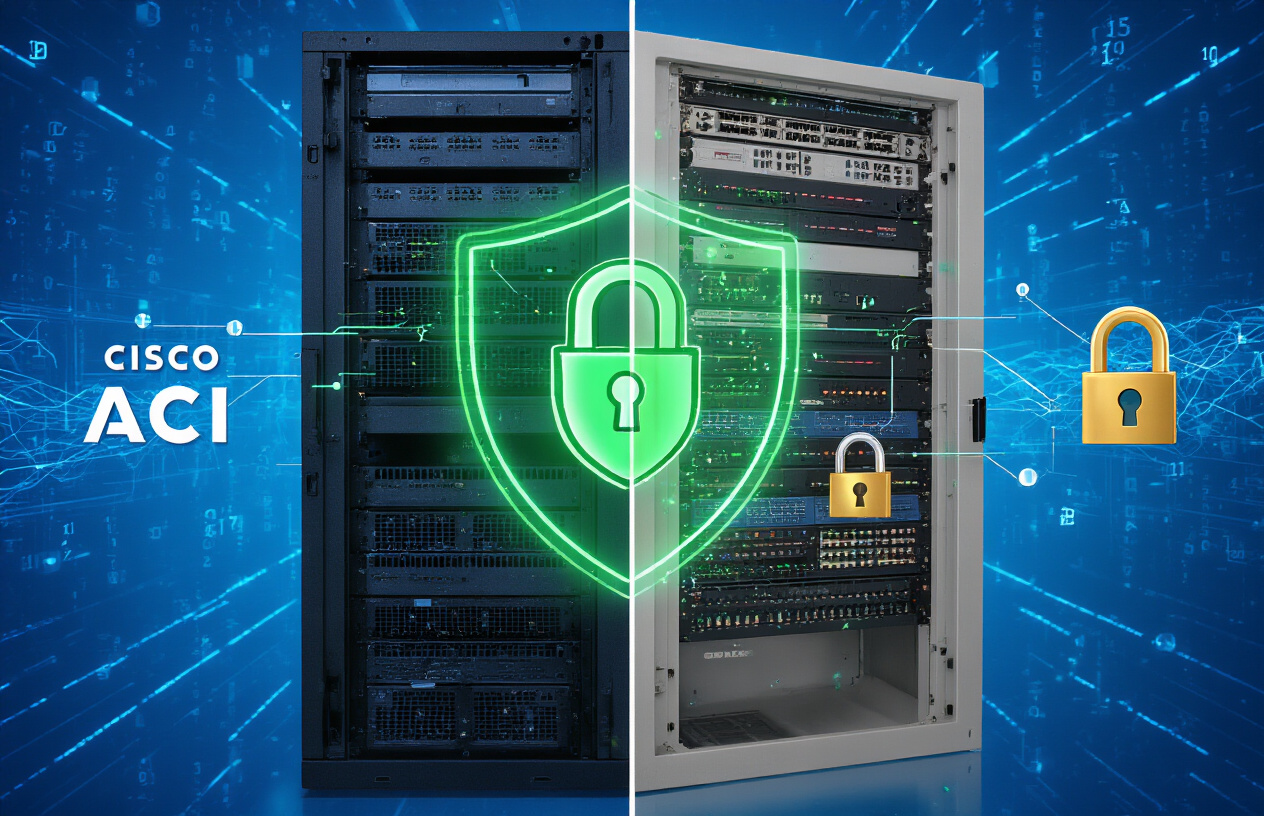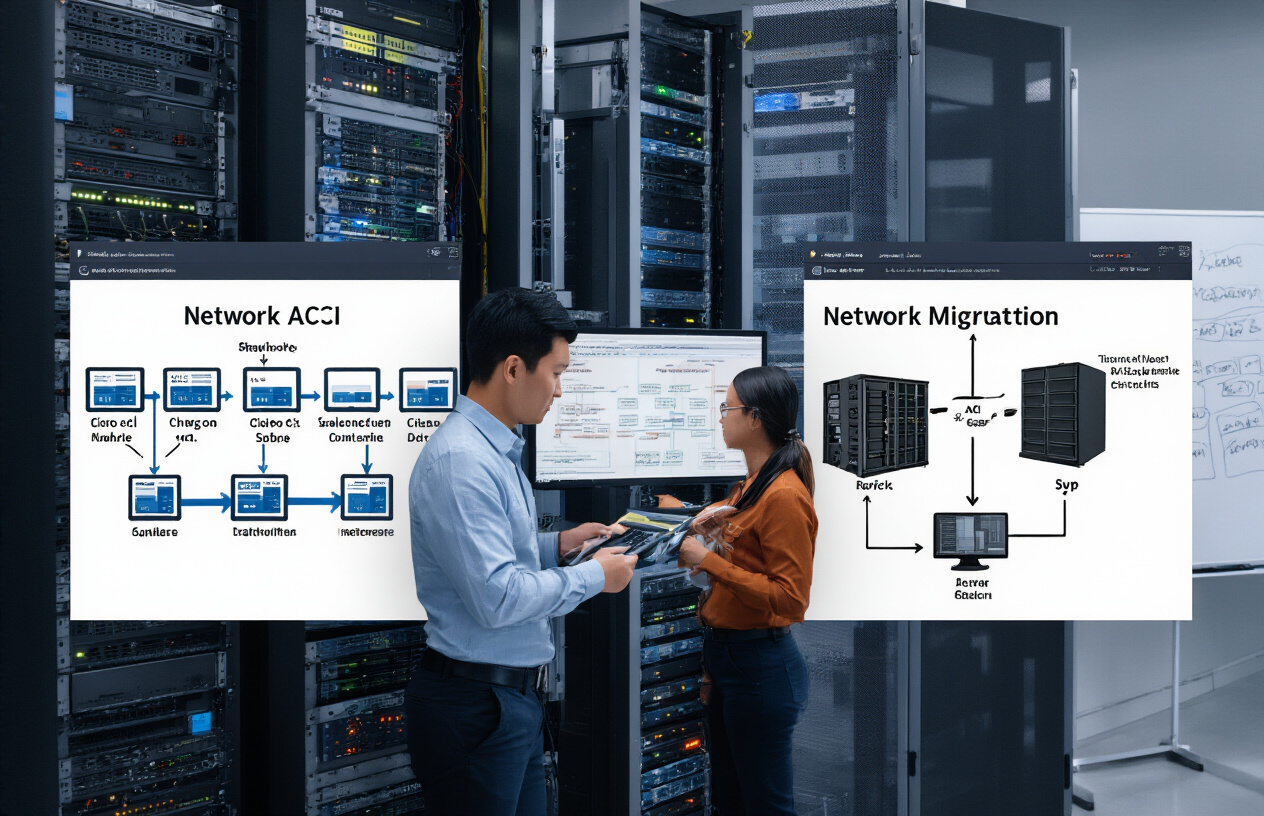Cisco ACI vs. Traditional Networking: Which is Better?
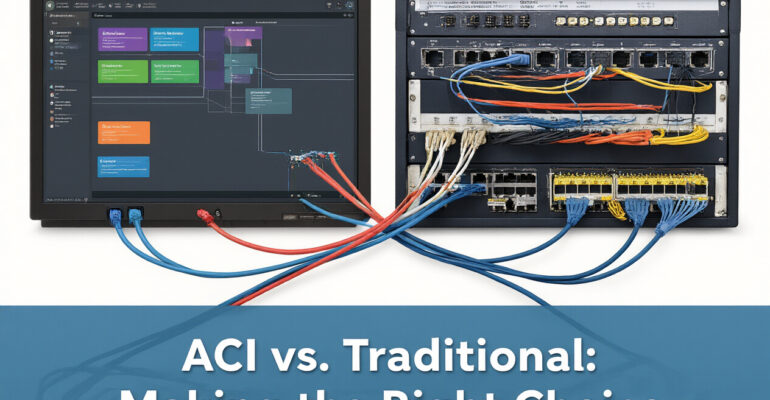
Cisco ACI vs. Traditional Networking: Which is Better?
You’ve been managing your network the same way for years, but suddenly everyone’s talking about Cisco ACI like it’s networking’s messiah. Feeling a bit lost in the SDN hype?
Let’s cut through the noise. By the end of this post, you’ll understand exactly when Cisco ACI makes sense—and when traditional networking still wins.
The battle between Cisco ACI and traditional networking isn’t just about technology. It’s about whether your business needs the agility and automation that software-defined networking provides, or if your current setup is actually the perfect fit.
The truth? Most network engineers get this decision completely wrong, wasting thousands on unnecessary complexity. Here’s the framework no vendor will tell you about…
Understanding Cisco ACI Architecture
Key Components of Cisco ACI
Cisco ACI isn’t just another networking solution—it’s a complete architecture overhaul. At its core sits the Application Policy Infrastructure Controller (APIC), essentially the brain of the operation. This centralized controller manages all policies and automatically pushes them to your network devices.
Then you’ve got the spine-leaf topology—a major departure from traditional three-tier architectures. Your leaf switches connect to endpoints while spine switches create a high-speed fabric between them. This design eliminates bottlenecks and keeps latency consistent regardless of which devices are communicating.
The third piece? The Nexus 9000 Series switches that power the physical infrastructure. These aren’t your average switches—they’re built specifically for ACI environments.
Policy-Based Automation Advantages
Gone are the days of manual CLI configurations and device-by-device management. ACI lets you define what you want (not how to do it) through policies that automatically configure your entire fabric.
This approach slashes configuration errors by up to 80% in most deployments. Plus, you can replicate policies across environments without rewriting everything from scratch.
The real magic happens with automation. Need to deploy a new application? Define the policy once, and ACI handles all the networking details automatically—firewall rules, load balancing, QoS settings—the works.
Application-Centric Approach Explained
Traditional networking thinks in VLANs, subnets, and ACLs. ACI thinks in applications.
With ACI, you define Application Network Profiles that contain all networking requirements for specific applications. These profiles group related services together as Endpoint Groups (EPGs) and establish contracts that control communication between them.
This flips the script completely. Instead of applications conforming to network limitations, your network adapts to what applications need. Want to move an application? The policies follow it automatically.
Scalability Features That Matter
Scaling traditional networks means complex reconfigurations and potential downtime. With ACI? Just add more leaf or spine switches and the fabric automatically incorporates them.
The distributed control plane handles massive endpoint growth without performance degradation. We’re talking about support for over 100,000 endpoints in a single fabric.
Multi-site capabilities let you stretch a single policy domain across multiple data centers or clouds. Deploy once, run anywhere—with consistent policies and security regardless of where workloads land.
Traditional Networking Fundamentals
Command-Line Interface (CLI) Management
Remember when networking meant memorizing hundreds of commands? Traditional networking is built on CLI – that command prompt where you type in exact syntax or face the consequences.
Network engineers spend years mastering these commands. Want to configure a switch port? That’s one command. Need to set up routing? Different command. Troubleshooting? Hope you remember the right “show” commands!
The CLI approach gives you granular control but at a cost. There’s no room for typos or syntax errors. One misplaced character and your change fails – or worse, breaks something unexpectedly.
What’s truly painful is the lack of standardization. Cisco IOS, Juniper JUNOS, Arista EOS – they all have different command structures. Moving between vendors feels like learning a new language every time.
VLAN and Spanning Tree Protocol Basics
Traditional networks rely heavily on VLANs to segment traffic. It’s essentially creating multiple virtual networks on the same physical infrastructure.
Spanning Tree Protocol (STP) keeps your network from melting down by preventing loops. Without it, broadcast storms would bring everything to a grinding halt. But STP comes with tradeoffs – it blocks redundant paths, meaning you’re paying for bandwidth you can’t use.
Setting up VLANs requires careful planning. You need to:
- Define VLAN IDs
- Assign ports to VLANs
- Configure trunks between switches
- Ensure consistent configuration across devices
Manual Configuration Workflows
Traditional networking is a manual affair. Each device needs individual attention, and changes follow a predictable (and tedious) pattern:
- Plan your change
- Create a maintenance window
- Back up current configs
- Implement changes device-by-device
- Test connectivity
- Document what you did
- Repeat for every network change
This approach is time-consuming and error-prone. Make a change to 50 switches? That’s 50 separate configurations, each with potential for human error.
Network Management Comparison
Centralized vs. Distributed Control Planes
Traditional networking is like having a bunch of independent decision-makers scattered throughout your organization. Each switch and router runs its own control plane, making decisions based on what it knows. Sure, they talk to each other, but they’re fundamentally independent entities.
Cisco ACI flips this model on its head. It pulls all those control plane functions into one central brain – the Application Policy Infrastructure Controller (APIC). This centralized approach means your entire fabric acts as a single, cohesive system rather than a collection of devices that need to coordinate.
The difference? Massive. With traditional networking, any network-wide change requires device-by-device configuration. With ACI, you make the change once in the APIC, and it propagates everywhere. No more hoping all your individual switches got the memo.
Configuration Time Requirements
Traditional networking can be a time sink. Consider what it takes to roll out a new application:
| Task | Traditional | ACI |
|---|---|---|
| VLAN creation | 30 mins | 2 mins |
| ACL implementation | 1-2 hours | 5 mins |
| QoS configuration | 45 mins | 3 mins |
With traditional networking, you’re logging into multiple devices, running commands, verifying, troubleshooting… rinse and repeat. ACI lets you define application requirements once and apply them everywhere instantly.
Troubleshooting Capabilities
Finding network problems in traditional environments feels like detective work. You hop from device to device, piecing together logs and hoping to spot the issue.
ACI gives you a single pane of glass with built-in tools that visualize the entire fabric. You can trace traffic flows end-to-end, view health scores, and instantly pinpoint exactly where things went sideways.
Maintenance Overhead Reduction
The maintenance math is simple:
Traditional networking means updating firmware device by device, often during maintenance windows at 2 AM. You’re doing upgrades serially, testing each one, and praying nothing breaks.
ACI handles updates in a coordinated, fabric-wide manner. The system knows dependencies and handles sequencing automatically. What used to take weekends can now happen during lunch.
Security Implementation Differences
A. Micro-Segmentation in Cisco ACI
Network security isn’t what it used to be. With Cisco ACI, micro-segmentation changes the game completely.
ACI lets you create security policies based on application needs rather than network topology. This means you can isolate workloads down to individual VMs or containers – something that’s nearly impossible in traditional networks.
The magic happens through ACI’s policy-based approach:
- Group applications with similar security requirements into EPGs (Endpoint Groups)
- Define contracts between these groups to control exactly who talks to whom
- Apply security at the microsecond level without complex ACLs
The result? An attacker who compromises one server can’t just hop to others on the same subnet. They’re contained, which dramatically reduces your attack surface.
What’s really cool is how ACI automates this. You define the policy once, and it follows the workload wherever it goes. Move a VM? The security moves with it. No human intervention needed.
B. Traditional Network Security Approaches
Traditional networks rely heavily on perimeter security – the classic “hard shell, soft center” approach. Once someone breaks through your firewall, they often have free reign inside.
Security in these environments typically means:
- Massive ACLs that nobody fully understands anymore
- VLANs and subnets for broad segmentation
- Firewalls between security zones
- Manual updates when anything changes
The biggest headache? Changes take forever. Adding a new server or application means updating firewall rules, ACLs, and routing policies across multiple devices. And each change brings risk of breaking something.
Plus, you’re constantly playing the “how many ACL entries can this switch handle?” game. Hit that limit, and you’re looking at expensive hardware upgrades.
C. Compliance and Audit Capabilities
Network audits strike fear into the hearts of admins everywhere – but not with ACI.
ACI offers built-in tools that make compliance a breeze:
- Automated documentation of all security policies
- Visual policy graphs showing exactly what’s permitted
- Historical tracking of who changed what and when
- Real-time compliance checking against your security rules
Traditional networks? Prepare for the audit scavenger hunt. You’ll be digging through configs on dozens of devices, trying to piece together your actual security posture.
What really stands out in ACI is the visibility. You can instantly see if a policy violates compliance rules, before you even deploy it. Try doing that with a stack of CLI configs!
For regulated industries, this difference is massive. When auditors come knocking, ACI lets you show exactly how traffic flows and what’s protected – with actual evidence, not just documentation that might be outdated.
Cost Analysis and ROI
Initial Investment Considerations
Choosing between Cisco ACI and traditional networking isn’t just a technical decision—it’s a financial one too. Up front, Cisco ACI hits your wallet harder. You’re looking at specialized hardware (Nexus 9000 switches), APIC controllers, and licensing that can make your CFO sweat.
Traditional networking? Much easier to swallow initially. You can mix and match vendors, buy just what you need right now, and scale up gradually.
But here’s the kicker—cheaper today often means pricier tomorrow.
Operational Expense Differences
This is where ACI starts to shine. Traditional networks are manual beasts—config changes, troubleshooting, and maintenance eat up countless hours of your team’s time.
With ACI, you’re automating repetitive tasks. Policy-based management means one change applies everywhere it needs to. Your network team spends less time on mundane tasks and more time on innovations that actually move the business forward.
Staff Training Requirements
Truth bomb: ACI requires a different skillset. Your network pros need to think less about CLI commands and more about application policies and intent-based configurations.
Training costs for ACI aren’t trivial—figure $3,000-5,000 per engineer plus the productivity hit during the learning curve.
Traditional networking? Your team already knows it. They can hit the ground running without expensive courses.
Long-Term Maintenance Costs
Traditional networks are maintenance nightmares:
| Traditional Networking | Cisco ACI |
|---|---|
| Manual updates to each device | Centralized updates |
| Complex troubleshooting | Built-in telemetry and visibility |
| Increasing complexity with growth | Consistent management regardless of scale |
As your network grows, maintenance costs for traditional networks grow exponentially, while ACI’s costs increase more linearly.
Return on Investment Timeframes
ACI typically pays for itself in 2-3 years—not overnight, but not forever either. The biggest returns come from:
- 70% reduction in network provisioning time
- 40% lower operational costs
- 80% faster troubleshooting
- Significantly reduced downtime
Traditional networking never delivers these efficiency gains, meaning your ROI timeline stretches much longer—if you ever truly recoup that ongoing operational spend at all.
Real-World Migration Scenarios
Hybrid Implementation Strategies
Transitioning from traditional networking to Cisco ACI doesn’t have to be a dramatic overnight shift. Many organizations start with a hybrid approach that makes perfect sense.
The most popular strategy? The pod-based approach. Companies segment their network into pods, migrating one pod at a time to ACI while the rest of the network runs on traditional protocols. This creates a controlled testing ground without disrupting the entire infrastructure.
Another smart tactic is application-based migration. Start with less critical applications, test the waters, then gradually move your mission-critical services once you’re comfortable with ACI’s behavior.
Some teams prefer the parallel network method—building a complete ACI fabric alongside their existing network, then migrating applications gradually. This takes more resources initially but minimizes disruption risks.
Common Migration Challenges
Nobody said moving to ACI would be a walk in the park. The skill gap hits hard—your networking team needs to embrace a new configuration mindset, shifting from CLI commands to policy-based thinking.
Documentation issues plague many migrations. Traditional networks often suffer from incomplete or outdated documentation, making it difficult to understand what you’re even migrating.
The application dependency mapping can be a nightmare too. Which application talks to what? Through which ports? With which security requirements? Without this clarity, you might break critical connections.
Budget constraints also create headaches. The initial investment isn’t just equipment—it’s training, possible downtime, and consultant expertise.
Success Stories and Case Studies
Financial giants like Capital One have successfully moved to ACI, reporting 80% faster application deployment times and dramatically reduced security incidents.
Healthcare provider Cleveland Clinic leveraged ACI to create secure segmentation between patient data systems and administrative networks, meeting strict HIPAA requirements while simplifying their overall architecture.
Tech company Cisco (yes, they use their own product) documented a 50% reduction in network provisioning time after fully adopting ACI across their data centers.
A global retailer with 5,000+ stores implemented ACI in stages over 18 months, starting with their development environments. The result? A 70% reduction in network-related outages and significantly improved application performance.
The common thread in successful migrations? Starting small, thorough planning, and investing in team training before the technical implementation begins.
Future-Proofing Your Network Decision
A. Technology Roadmap Considerations
Making a network choice today means thinking about tomorrow. Cisco ACI isn’t just a current solution—it’s built with the future in mind. Their development team constantly rolls out features that adapt to changing tech landscapes.
Traditional networking? It’s reliable but often slow to evolve. You’ll get updates and patches, sure, but revolutionary features? Don’t hold your breath.
Ask yourself: Where do you want your network to be in five years? ACI’s programmable fabric gives you room to grow without ripping everything out and starting over.
B. Vendor Lock-in Factors
Nobody likes feeling trapped. With traditional networking, you’re often stuck with a single vendor’s ecosystem. Want to switch? Prepare for painful migrations and compatibility headaches.
ACI isn’t perfect here either—it’s still Cisco’s world. But its open APIs and support for third-party devices give you breathing room. You can integrate non-Cisco components without everything falling apart.
| Aspect | Traditional Networking | Cisco ACI |
|---|---|---|
| Ecosystem flexibility | Limited, often single-vendor | More open with multi-vendor support |
| Migration difficulty | High | Moderate |
| API availability | Limited | Extensive |
C. Integration with Emerging Technologies
The tech world doesn’t sit still. IoT, AI, machine learning—they’re all knocking at your network’s door.
Traditional networks weren’t designed with these technologies in mind. Adding them often feels like attaching rocket boosters to a bicycle—technically possible but awkward.
ACI’s policy-based approach makes it play nice with these newcomers. Its centralized management means you can implement IoT security policies once and apply them everywhere. No more device-by-device configuration nightmares.
D. Cloud Compatibility Advantages
Cloud isn’t just coming—it’s here. Your network needs to extend seamlessly between on-premises and cloud environments.
Traditional networks struggle with this hybrid reality. Different management tools, different security models, different everything.
ACI bridges this gap with Cisco Cloud ACI. Same policies, same interface, whether your workloads live in your data center, AWS, Azure, or Google Cloud. This consistent experience isn’t just convenient—it’s a massive time-saver and security enhancer.
The decision between Cisco ACI and traditional networking ultimately depends on your organization’s specific needs, budget constraints, and long-term strategic goals. While traditional networking offers simplicity and familiarity, Cisco ACI provides a more scalable, automated, and policy-driven approach that can significantly reduce operational complexity in large environments. The security benefits, centralized management, and improved application performance of ACI present compelling advantages for organizations undergoing digital transformation.
As you evaluate your networking strategy, consider starting with a thorough assessment of your current infrastructure, application requirements, and team capabilities. Whether you choose to implement ACI, stick with traditional networking, or adopt a hybrid approach, focus on building a network foundation that can adapt to emerging technologies and business demands. The right choice will align with both your immediate operational needs and your vision for future growth.

